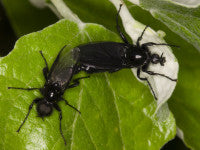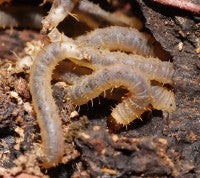You give me Fever!
 There are two Bibionid flies that are common to amenity turfgrass areas. One is the St Mark's Fly and the other is the Fever Fly. These flies cause no damage in their adult form and are thought to be beneficial pollinators of fruit and other crops. However, their larvae do cause damage to turf by feeding on the roots and reducing water and nutrient uptake.
There are two Bibionid flies that are common to amenity turfgrass areas. One is the St Mark's Fly and the other is the Fever Fly. These flies cause no damage in their adult form and are thought to be beneficial pollinators of fruit and other crops. However, their larvae do cause damage to turf by feeding on the roots and reducing water and nutrient uptake.
The adult St Mark's Fly (Bibio marci) is the largest of the Bibionidae family of black, day-flying midges and is between 10-13mm in length with the female being slightly larger than the male. The noticeably hairy St Mark's fly is quite slow in flight and appears to almost 'hang' in the air with its legs dangling beneath it.
Not only are the females larger than the males but there are distinct differences between the head structures too, should you want to get close enough to see them!
 The slightly smaller Fever Fly (Dilophus febrilis) is a relatively small (4-6 mm or less), stout, black fly which is not as hairy as the St Mark's fly. The female has darkly tinted wings giving them an almost smokey, opaque appearance whereas the wings of the male are clear with a black mark.
The slightly smaller Fever Fly (Dilophus febrilis) is a relatively small (4-6 mm or less), stout, black fly which is not as hairy as the St Mark's fly. The female has darkly tinted wings giving them an almost smokey, opaque appearance whereas the wings of the male are clear with a black mark.
The St Mark's Fly appears between the end of April and early May, but the Fever Fly appears between March and October, commonest during late spring.
After mating, the female lays up to 300 eggs at a time, and this results in small clumps or pockets of larval activity in the rootzone. The eggs are laid between May and August/September and hatch from late summer, producing larvae that will feed on the organic matter in the rootzone or the roots themselves.
Damage is often seen either in November/December or in January/February as small yellowing patches throughout the sward.

If the damage to the turfgrass roots is extensive enough, the yellowed plants will eventually die. The adult fly will emerge from the pupal stage to initiate a new life cycle.
Although these pests are flies in their adult form, their larvae have a small dark head with well-developed mouthparts, similar at first glance to that of the chafer larvae. However, the Bibionid larvae do not have either legs or pro-legs and their body is relatively long and thin.

The larvae will vary in size depending on their age, but will grow to around 11mm long and 1.5-2.0mm wide. Identification of the different Bibionid species requires microscopic analysis of certain details on the larval segments.
Insecticides that are used to control leatherjackets (larvae of the Crane Fly, (Tipula sp.) will also have an effect on Bibionid larvae. However, timing of the insecticide application is important because, during November/December, the larvae are relatively small and closer to the surface of the rootzone, whereas during January/February, the larvae will have grown significantly in size and will start to move deeper in to the profile.
Dr Kate Entwistle,
The Turf Disease Centre
Email: kate@theturfdiseasecentre.co.uk
Website: www.theturfdiseasecentre.co.uk
